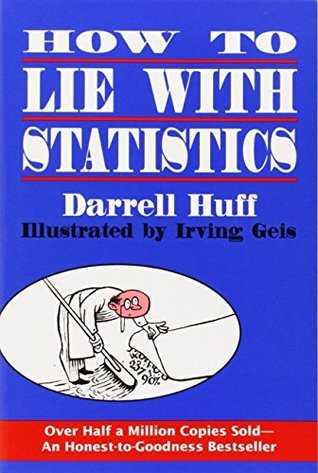Explore the World's Best Ideas
Join today and uncover 100+ curated journeys from 50+ topics. Unlock access to our mobile app with extensive features.
The abused statistic
Averages, relationships, trends and graphs are not what they seem. Statistics can make an important fact look as if it is nothing noteworthy and a trivial fact like there may be more in it.
Writers need statistical methods and statistical terms when reporting data of social and economic trends, but they need to use the words honestly, and readers need an understanding of what they mean. Otherwise, it may result in semantic absurdity.
409
2.91K reads
“The secret language of statistics, so appealing in a fact-minded culture, is employed to sensationalize, inflate, confuse, and oversimplify.”
DARRELL HUFF
405
2.7K reads
The representative sample
For any statistic to be worth it, it should come from a representative sample of the group it is describing. But a representative sample is near impossible because of lack of time, resources, and other practical reasons. As a result, you are more likely to see a subset based on biases from the method of sampling rather than the representative group itself.
When you see the statistic that, for example, represent the entire nation, ask yourself, “Which part of the nation?”
410
1.49K reads
The kind of average
There are three common kinds of average:
- Mean. Add up all the values and divide by the quantity of the values.
- Median. The value in the middle of the sample.
- Mode. The most common value.
When a statistic cites the “average”, it could be the mean, median or mode, which can be drastically different. The unspecified “average” is used to prove a point while leaving out any numbers that might question their predetermined point.
416
1.52K reads
Consider what it really measures
If you want to use a test to measure something or somebody, it is equally important to know the limitations of the test. What can it not measure?
For example, an intelligence test does not measure leadership, creative imagination, diligence, and emotional balance. The test may still be useful for admission to a university or a job, but you should also understand its limitations.
408
1.29K reads
Statistics are always biased
“As long as the errors remain one-sided, it is not easy to attribute them to bungling or accident.”
Statistics are often used to support a cause or agenda a person believes in, rather than to disprove them. When people err in their use of statistics, it is always in the direction of their beliefs or agenda. So, instead of getting an unbiased view of the world, we get a biased view that other people want us to see.
410
1.11K reads
The common-sense test
“‘Does it make sense?’ will often cut a statistic down to size when the whole rigmarole is based on an unproved assumption.”
Consider what they are saying and why they are saying it. If a statistic doesn’t seem right, or someone arrives at a conclusion that seems questionable, ask “Does it make sense”.
401
1.15K reads
The semidetached figure
It describes using one thing as a way to claim proof of something else, even if there exists no correlation between the two.
Meaningless statements:
- “32% of doctors think Mercedes vehicles are safe."
- “27 % of a large sample of eminent physicians smoke Throaties— more than any other brand.”
Expressing the data to suit your view. For instance, express exactly the same fact by calling it a one % return on sales, a fifteen % return on investment, a ten-million-dollar profit, or a decrease of sixty % from last year.
401
1K reads
Correlation vs. Causation
If B follows A, then A has caused B.
For example:
- Assuming that since smoking and low grades go together, smoking causes low grades.
- If you attend college, you will earn more money than if you decide to use the next four years in another way. The unwarranted assumption is that since college-trained people make more money, they make it because they went to college. However, we don’t know if these people would have made more money had they not gone to college.
408
942 reads
How to avoid blind belief in statistics
- Who says so? What is the agenda? Who will benefit from presenting the data that way? Does it tell the whole story or only the good or bad part? Does it misuse average? Does any bias come into play?
- How do they know? Where did the data come from? Is it representative? Can it be biased? Is the sample big enough?
- What’s missing?
- Did someone change the subject between the raw data and the conclusion? Is it a real statistic, or what someone reported?
- Does it make sense? Pay attention if it fails the common sense test. Is something complex reduced to a single number?
440
840 reads
IDEAS CURATED BY
CURATOR'S NOTE
This book lays the groundwork for the many ways statistics are used to mislead people. Honest people must learn the tricks of statistics so that they can interpret data intelligently.
“
Lila H.'s ideas are part of this journey:
Learn more about problemsolving with this collection
Conducting effective interviews
Identifying the right candidates for the job
Creating a positive candidate experience
Related collections
Different Perspectives Curated by Others from How to Lie with Statistics
Curious about different takes? Check out our book page to explore multiple unique summaries written by Deepstash curators:
12 ideas
Discover Key Ideas from Books on Similar Topics
13 ideas
The Monk Who Sold His Ferrari
Robin Sharma
10 ideas
The Monk Who Sold His Ferrari
Robin Sharma
11 ideas
Surrounded by Idiots
Thomas Erikson
Read & Learn
20x Faster
without
deepstash
with
deepstash
with
deepstash
Personalized microlearning
—
100+ Learning Journeys
—
Access to 200,000+ ideas
—
Access to the mobile app
—
Unlimited idea saving
—
—
Unlimited history
—
—
Unlimited listening to ideas
—
—
Downloading & offline access
—
—
Supercharge your mind with one idea per day
Enter your email and spend 1 minute every day to learn something new.
I agree to receive email updates



